Iontophoresis devices by Hidrex
Hidrex, an experienced manufacturer of iontophoresis devices
Hidrex has been a big name in the field of iontophoresis well before the first iontophoresis studies. To this day, the majority of clinical studies on iontophoresis have been carried out using Hidrex iontophoresis devices.
Hidrex is considered a driving engine of the development in the field of iontophoresis technology.
We owe in-depth knowledge on iontophoresis to this manufacturer, as well as the introduction of pulsed current in home therapy devices.
The latest achievement generated under the leadership of Hidrex is the variable pulsed current, which is used in the Hidrex connectION.
The variable pulsed current sets high standards for iontophoresis.
This technology allows the user to adjust the pulse width appropriately in 6 steps, ranging from a soft current (at 50% pulse width) to a hard current. Once the maximum current has been reached with a lower pulse width, it is possible to increase the pulse width and optimize the current.
Likewise, if the desired current cannot be reached with a higher pulse width, it is possible to switch to a lower pulse width of 50%.
At fifty percent pulse width, the current is set to the gentlest, but also the least effective level.
To achieve the best possible effectiveness, higher pulse widths are recommended. For the hand treatment, a pulse width of 70-80% is standard, feet are often treated at 90%. Thus, the pulse width can easily be adjusted to all of your needs and different body parts.
All of our Hidrex devices offer a pulse width of 100%, which corresponds to a direct current. With the setting of 100%, the advantages of the pulsed current are lost.
Top technology – amazing equipment – Hidrex is a great choice!
Hidrex ConnectION and ClassicION
The latest Hidrex devices are the Hidrex connectION and the Hidrex classicION.
No pain – short iontophoresis treatment times
We recommend setting the iontophoresis current to a pain-free level. It should be just high enough to avoid discomfort.
The value at which the pain sets in is called pain threshold.
The more sensitive the skin and the iontophoresis user, the faster the pain threshold is reached.
Many users who use direct current reach this threshold very fast. Logically, this means that they must set low currents to tolerate the therapy.
Low currents are usually less effective than higher currents.
The pain threshold can often be avoided with a gentle pulsed current. The increased therapy comfort allows you to reach higher currents.
If the pain threshold is not reached with a gentle pulsed current despite the high current intensity, the current can be adjusted to slightly harder and more efficient levels with the Hidrex connectION.
This means that the maximum current yield (energy & effectiveness) increases parallel to the pulse width while maintaining your comfort.
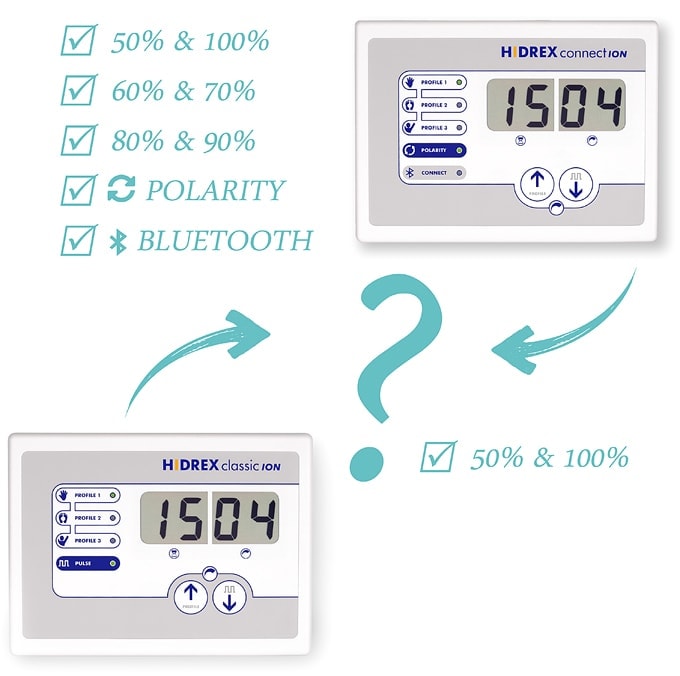
Current yield (or energy input) in relation to the duration of the iontophoresis treatment.
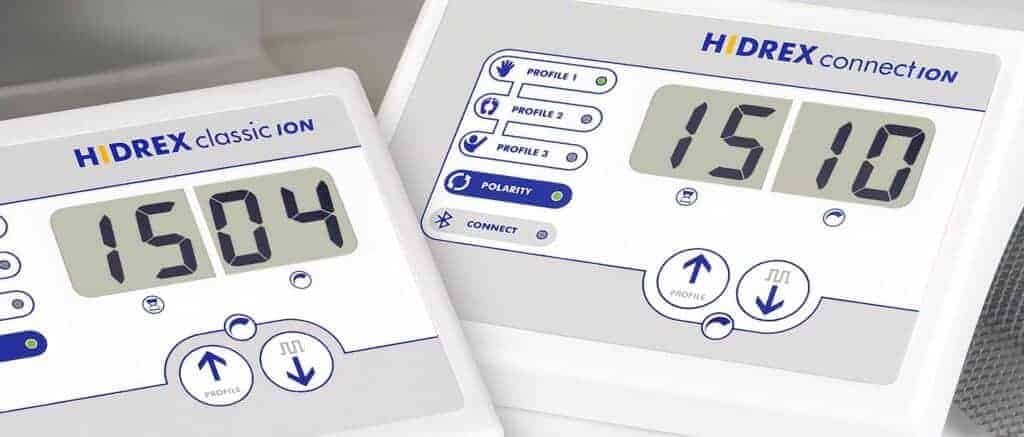
Once the pain threshold has been reached in one specific “gear” (pulse width), the energy input can only be controlled by changing the treatment time.
Therefore, if you have reached a point at which neither the current nor the pulse width can be increased, your only option is to extend the treatment time.
Obviously, longer treatment times are not ideal.
This is why a device with many different “gears” to choose from is a great option to influence the effectiveness of the current.
Iontophoresis - too complicated?
One nice metaphor to use is that of a bicycle and a mountain.
Imagine a slope (the representation of your personal perception of pain) and a bicycle (your tool: iontophoresis).
The top of the mountain beckons with a beautiful view, the satisfaction of your achievement, and anticipation of new things to come.
Which bike would you choose? The one with 2 gears or the one with 6 gears?
Riding in high gear at 100%, you may never reach the mountain top, since the mountain is too steep. Choosing the low gear at 50%, your journey will take much longer than necessary. A bike that offers a 5th gear at 90% would take you to the top much faster, at almost double the efficiency.
What the current feels like at different pulse widths
As long as you ride the “pulsed gears”, the current sensation is not at all comparable to a direct current.
Many users experience and describe the treatment sensations as follows:
The change from 50% to 60% pulsed current brings only a small increase of the current sensation, as the current becomes denser.
Each new upwards step of the pulse width brings a similar increase, always minimally stronger than the step below.
The last change from 90% pulsed current to 100% direct current is perceived as much more extreme than jumping directly from 50% to 90%.
If we apply the same logic to the pedaling speed of the bike driving up the mountain, we could say that:
Adjusting the gear from 50% to 90% at the rear wheel = little change.
Adjusting the gear from 90% to 100% at the front wheel = big change.
This would explain why so many users fail the therapy with direct current, while some go uphill quite easily with pulsed currents.

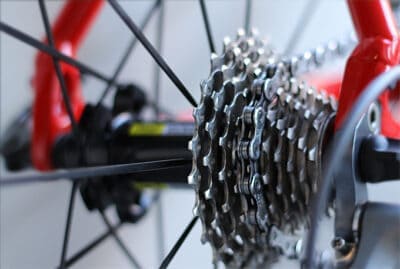
Pulse width change and its influence on the maximum possible current
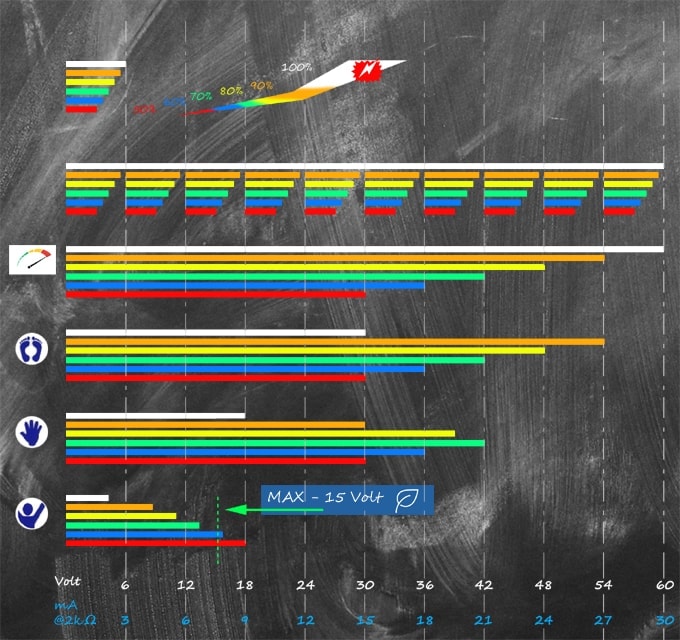
Full view of the graphic
Pictured above: possible/realistic/achievable currents in different pulse widths
Characteristic distance: 100 pixels
From the top: One cycle depicting the percentage of the pulse width, 10 pixels = 10% pulse change.
Directly next to it, symbolic:
Increase of the current sensation within the individual pulse widths, linear increase of the current sensation at 50%-90%, exponential increase at the change to 100%.
Below: 10 successions with different pulse widths. The colors depict when and for how long the current flows.
For a better overview, the pauses in the current were omitted in the illustration.
This depiction makes it easier to see how much current can flow within 10 cycles at different pulse settings, using Hidrex as an example.
Display with tachometer: The first 10 cycles represent the maximum achievable current, which flows when all pulse widths can be extended to the maximum. Here, 10 pixels correspond to 0.6 volts.
The next lines describe a realistic application of the treatment for sweaty feet. With direct current, only half of the maximum current can be reached in many cases, whereas maximum current strengths are realistic with all pulsed currents.
For the hands: Depicted is a case in which only a quarter of the direct current can be withstood at most, while the current can be fully turned up in pulse widths below 70%. This is a realistic scenario for the hand treatment.
For the armpits: Here, we must take into account the manufacturer's recommended current limit. It is assumed that currents below volts are tolerable with direct current. In our example, we would exceed the recommended current limit if turning up the current fully at a pulse width of 50%. 60% would be just right, but the current should not be adjusted to a value above the recommended maximum of 15 volts. At values above 60% pulse width, the tolerable current values average lower.
We tried to reflect values that are realistically achievable in our average amperage values, drawing from our own experiences and those of our customers. Of course, these values do not apply to everyone. Some users can achieve the maximum current for their hands and feet while treating with direct current, some even use direct current when treating the armpits and are easily able to achieve a maximum of 15 volts. For most, however, such a scenario is unrealistic. Indeed, many users are too sensitive to reach the values used in our example.
Give it a try! Should you find that you don't need the pulsed currents at all, we will send you a return ticket and exchange your iontophoresis device for a more affordable option. All price differences will be settled. However, from our long-standing experience, almost no users ever regret their choice.
Don't forget about another advantage of the variable pulsed current:
The sensation of the current increase (that is, during the time when the device amps up the current) differs greatly between individuals.
Each gear feels different for every user. If the treatment sensation is unpleasant in one gear, it can feel vastly different in another gear.
Therefore, you can choose a lower or higher pulse width that feels more comfortable to you while the device is increasing the current.
This allows you to play with the different values and optimize the therapy according to your needs.
The goal is to reach the best treatment feeling with the most pleasant current and the lowest time investment.
The Hidrex current that is most gentle and most effective at the same time.
We have observed that the following settings will achieve the most pleasant treatment feeling during the current increase:
- Armpit mode: 60%
- Hands: 70-80%
- Feet: 80-90%
- Very sensitive areas: 50%
Often, these are the settings that achieve the best current values for the respective skin areas.

Which tool should I choose? The one with 2 gears or the one with 6?
With the Hidrex classicION, we offer a conventional iontophoresis device with two gears: 50% and 100%.
With the Hidrex connectION, we offer an iontophoresis device with 6 gears. It has 5 pulse settings, which allows a choice of 50%, 60%, 70%, 80% and 90%. In addition, there is also a classic direct current setting (100%).
Don't underestimate the time factor!
How much time anyone needs for iontophoresis is highly individual. The usual standard is ~30 minutes per week. Of course, it helps to adjust your therapy as well as you can. If you manage to save 50% of your time by optimizing the therapy
, you can save 240 hours in 20 years of therapy as compared to the 30 minutes per week you needed before.
This may not sound like much.
Therefore, let us look at another extreme:
If you treat your hands, feet, and armpits for half an hour every day, it's worth figuring out how to optimize your therapy to save time.
If you could save 66% of your treatment time, this would add up to 6720 hours or 280 days. Wow!
The potential for an optimization of the iontophoresis therapy is usually abundantly high due to the individuality of the treatment.
And that's not all: the Hidrex connectION
can be operated via app.
The app is under continuous development, but it already offers a clear insight into the therapy. It shows parameters such as pulse/pulse width, the remaining time, the current (in volts and mA), and allows an insight into your body resistance. This enables clearer conclusions regarding the effectiveness of a pulse width.
A high body resistance may result in an unnecessarily high current setting. If the body resistance could be reduced to fit the normal range of the iontophoresis device, it would be possible to reduce the pulse and increase the current. This is just one example of optimization.
Goal: Reducing the treatment time and maintaining an ideal, comfortable treatment feeling.
A common trait of both devices:
The connectION and the classicION offer 3 basic settings and a free memory bank.
This means that 4 programs can be used in total.
The 3 programs with graphics for hands, feet and armpits are adjusted to sensible values in the factory setting. These values can be changed by the user.
With these settings, an efficient iontophoresis therapy is possible from the beginning and can be further optimized once you are familiar with the treatment.
Visit our UK-Partner iontocentre
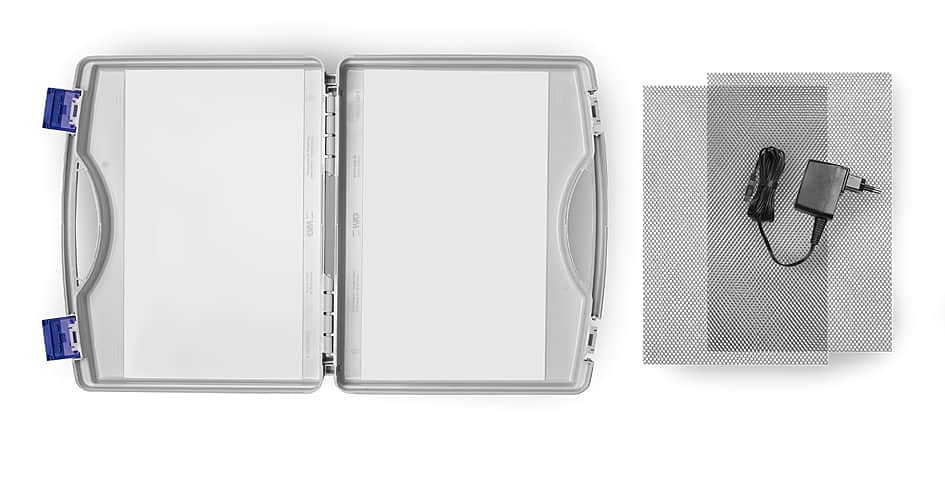
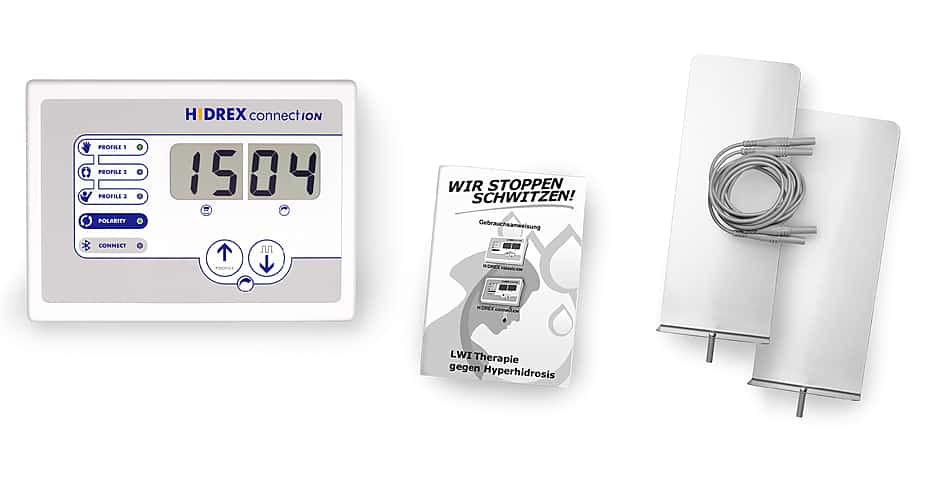
IONTOPHORESIS Devices by Hidrex
Switchable device
Direct & 50% pulsed current
VPC Iontophoresis device
variable pulsed current
In Steps Of 10
Or choose a simple monthly rent
